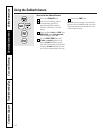
15
Safety Instructions
Operating Instructions Care and Cleaning
Troubleshooting Tips Consumer Support
Adjust the oven thermostat—Do it yourself!
ge.com
You may find that your new oven cooks differently than the one it replaced. Use your new oven for a few weeks to
become more familiar with it. If you still think your new oven is too hot or too cold, you can adjust the thermostat yourself.
Do not use thermometers, such as those found in grocery stores, to check the temperature setting of your oven.
These thermometers may vary 20–40 degrees.
NOTE: This adjustment will not affect the broiling or the self-cleaning temperatures. The adjustment will be
retained in memory after a power failure.
To Adjust the Oven Thermostat (on the upper oven)
Touch the BAKE and BROIL HI/LO
pads at the same time for 3 seconds
until the display shows SF.
Touch the BAKE pad. A two digit
number shows in the display.
The oven temperature can be
adjusted up to (+) 35°F hotter or
(-) 35°F cooler. Touch the + pad
to increase the temperature in 1
degree increments. Touch the
– pad to decrease the temperature
in 1 degree increments.
When you have made the
adjustment, touch the START pad
to go back to the time of day
display. Use your oven as you
would normally.
To Adjust the Oven Thermostat (on the lower oven)
Pull the OVEN knob off the shaft, look
at the back of the knob and note the
current setting before making any
adjustment. The knob is factory set with
the top screw directly under the pointer.
Pull off the OVEN knob.
Loosen both screws on back of
the knob.
Hold both parts of the knob as
shown in the illustration of the back
of the OVEN knob and turn so the
lower screw moves in the desired
direction.
You will hear and feel the notches as you
turn the knob. Each notch changes
temperature about 10° Fahrenheit.
Tighten the screws.
Return the OVEN knob to the oven.
Re-check oven performance before making any
additional adjustments.
The type of margarine will affect baking performance!
Most recipes for baking have been developed using high fat products such as butter or margarine (80% fat). If you
decrease the fat, the recipe may not give the same results as with a higher fat product.
Recipe failure can result if cakes, pies, pastries, cookies or candies are made with low fat spreads. The lower the fat
content of a spread product, the more noticeable these differences become.
Federal standards require products labeled “margarine” to contain at least 80% fat by weight. Low fat spreads, on the
other hand, contain less fat and more water. The high moisture content of these spreads affect the texture and flavor
of baked goods. For best results with your old favorite recipes, use margarine, butter or stick spreads containing
at least 70% vegetable oil.
Turn the disk counterclockwise to
increase the oven temperature.
Turn the disk clockwise to decrease
the oven temperature.


















